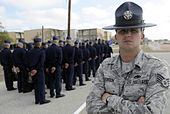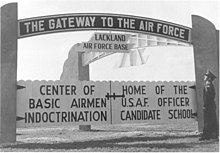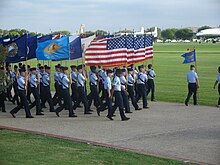United States Air Force Basic Military Training
The goal is to instill a warrior mindset in trainees from day one and better prepare Airmen for the realities of the operational Air Force.
In September 2004, the 20th Basic Military Training Review Committee met at Lackland and recommended significant changes in the focus, curriculum, and schedule.
[2] In 2011, it was revealed that a number of military training instructors engaged in inappropriate and illegal sexual relationships and advances against dozens of female trainees.
Prior to arriving at basic training, all prospective trainees undergo a physical examination by a doctor at their local Military Entrance Processing Station, or MEPS.
Trainees will then be rushed up to their dorm rooms, where they will be given a bed and a wall locker (personal living area or PLA) that they will take care of for the next seven and a half weeks.
They will also be briefed on meal time procedures in the dining facility (DFAC) and other essential ground rules that will apply throughout the duration of basic training.
The trainees are given an opportunity to phone a family member to inform them of safe arrival and mailing instructions, then are searched for contraband—this is called a shakedown.
As the initial uniform issue is not until the following Thursday or Friday, trainees will be required to wear civilian clothes for at least one full day.
Trainees will be expected to adhere to the rules by this time or face correction by physical exercise, or go through the chain of command—beginning with the section supervisor, depending on the severity of the misconduct.
The following chart shows physical fitness achievement levels as well as the minimum requirements for graduating Air Force Basic Military Training: This is the Pre-Deployment Phase.
Activities include basic Rifle Fighting techniques, crawling through a sand course and learning how to move in columns and use proper hand signaling.
These skills and tactics the trainees have learned will be put to test in realistic field training exercises and combat scenarios.
The site has four zones, called Reaper, Phantom, Vigilant and Sentinel, that simulate self-contained forward operating bases.
Each zone is a ring of 10 field tents for barracks, centered around a three-story observation tower and a hardened briefing facility that serves as an armory and bomb shelter.
[18] The BEAST site includes a 1.5-mile improvised explosive device (IED) trail littered with simulated roadside bombs.
For example, under one scenario trainees make their way down the "lane" in tactical formation, trying to identify IEDs from the other debris such as soda cans.
At the end of the trail, trainees are broken into teams of two "wingmen" and negotiate a combat-obstacle course (low-crawl, hide behind walls, roll behind barriers, strike dummies with the butt of your rifle, high crawl 60 yards through deep sand up a 40 percent grade).
They will then move in staggered tactical formation to another checkpoint where they will work on their SABC skills, then they will go through the combat obstacle course that was mentioned above.
During this week, they will receive intensive classroom instruction about the difficulties many military members face when they return from a deployment, such as financial management, family issues and alcohol abuse.
The flights will pass in review, take their final oath of enlistment and are then dismissed which marks the end of Air Force Basic Military Training and the beginning of an Airman's career.
The weekend will be spent returning to the flight in the evening and spending the daylight hours on Base Liberty or Town Pass.
During this week, Airmen are granted more freedoms, including base liberties after duty hours and a more relaxed dining facility.
Monday morning following the end of Airman's Week, all Airmen will proceed to the appropriate technical training school for their Air Force Specialty Code.
An Article 15 disciplinary action may entail any or all of the following: A trainee can be discharged from the Air Force before the conclusion of Basic Military Training.











